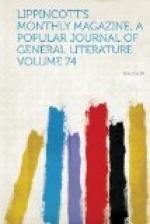The names of these fellows, as translated for us by the interpreter, were odd enough. Besides the great chiefs, Red Cloud and Spotted Tail, there were Red Dog, Red Leaf, Red Horse, Little Wound, White Crane Walking, Man Afraid of (Losing) his Horses, Crow that don’t like Water, Man who Sings in the Long Grass, Turkey Legs, Lone Horn, Sitting Bull, Spider, Yellow Bear, Blue Horse, Two Strike, White Crow, Long John, Friday, Face, Hand, Man that Sleeps under the Water, Man that Looks the Sun blind, Wish, Three Bears, Blue Tomahawk, White Thunder, etc., etc. These Indians were Sioux of the wildest kind, about as savage as any there are. Our lives were in their hands, and they were well mounted and well armed. Still, we were safe enough so near the camp, for they are very prudent, and never attack unless they are five to one. Besides, they have rations given them every ten days by government, and they don’t quarrel much with their bread and butter. In fact, they are paupers, and we are all taxed to support them and the army which is more than necessary as a police to keep them in order. When the dance was half over about twenty soldiers came into the gate and produced quite a panic among the squaws and children, who shrieked with terror and rushed toward the larger gate. The braves did not think it the correct thing to show any fear.
One might live a thousand years at the East and never see anything so wonderful as this dance: it is impossible to give a true idea of its life and color. It was the real thing, not a theatrical or Cooperesque imitation. All was new to us, and we were probably as new and strange to most of our entertainers. Many crowded round us with evident curiosity, desiring to shake hands with us and to say, “How? Kola! (friend).” Those who could speak a few words of English plied us with questions as to our ages, the relationships that existed between us, whose squaws the ladies were, and whose were the little blond-haired children. Certain articles of finery seemed to be greatly valued among them,




